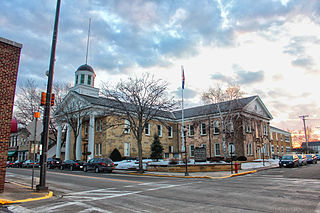
Lafayette County, sometimes spelled La Fayette County, is a county located in the U.S. state of Wisconsin. It was part of the Wisconsin Territory at the time of its founding. As of the 2020 census, the population was 16,611. Its county seat is Darlington. The county was named in honor of the Marquis de Lafayette, the French general who rendered assistance to the Continental Army in the American Revolutionary War. The courthouse scenes from the 2009 film Public Enemies were filmed at the Lafayette County Courthouse in Darlington.

Iowa County is a county in the U.S. state of Wisconsin. As of the 2020 census, the population was 23,709. Its county seat and largest city is Dodgeville. When created, it was part of the Michigan Territory. Iowa County is part of the Madison, Wisconsin, Metropolitan Statistical Area.

Pecatonica is a village in Winnebago County, Illinois, United States. It is part of the Rockford, Illinois Metropolitan Statistical Area. The population was 2,195 at the 2010 census, up from 1,997 in 2000.

DeForest is a village in Dane County, Wisconsin, United States, along the Yahara River. The population was 10,811 at the 2020 census. It is part of the Madison Metropolitan Statistical Area.

Jordan is a town in Green County, Wisconsin, United States. The population was 577 at the 2000 census. The unincorporated community of Jordan Center is located in the town.

York is a town in Green County, Wisconsin, United States. The population was 910 at the 2010 census. The unincorporated community of Postville is located in the town. The ghost town of Farmers Grove was also located in the town.

Blanchard is a town in Lafayette County, Wisconsin, United States. The population was 264 at the 2010 census. The town was founded in the 1840s by a branch of the Church of Jesus Christ of Latter Day Saints led by James Jesse Strang. It was named for Alvin Blanchard, who jointly owned the site along with Cyrus Newkirk.

Fayette is a town in Lafayette County, Wisconsin, United States. The population was 376 at the 2010 census. The unincorporated communities of Fayette and Yellowstone are located in the town.

Lamont is a town in Lafayette County, Wisconsin, United States. The population was 314 at the 2010 census, up from 267 at the 2000 census. The unincorporated community of Lamont is located in the town.

Wayne is a town in Lafayette County, Wisconsin, United States. The population was 490 at the 2010 census.

Wiota is a town in Lafayette County, Wisconsin, United States. The population was 856 at the 2010 census. The unincorporated communities of Wiota, Woodford and Five Corners are located in the town.

Valders is a village in Manitowoc County, Wisconsin, United States. The population was 962 at the 2010 census.
Gratiot is a town in Lafayette County, Wisconsin, United States. The population was 550 at the 2010 census, down from 653 at the 2000 census. The village of Gratiot is located within the town. The unincorporated community of Riverside and part of the unincorporated community of Dunbarton are also in the town.

Oregon is a village in Dane County, Wisconsin. As of the census of 2020, the population was 11,179. Oregon is part of the Madison Metropolitan Statistical Area. The village is located mostly within the Town of Oregon.
Argyle is a town in Lafayette County, Wisconsin, United States. The population was 436 at the 2010 census, down from 479 at the 2000 census. The village of Argyle is located within the town.

Argyle is a village in Lafayette County, Wisconsin, United States. The population was 857 at the 2010 census, up from 823 at the 2000 census. The village is located within the Town of Argyle.
Darlington is a town in Lafayette County, Wisconsin, United States. The population was 875 at the 2010 census, up from 757 at the 2000 census. The city of Darlington, the Lafayette county seat, is located within the town. The unincorporated settlement of Red Rock is in the east part of the town.

Darlington is a city in and the county seat of Lafayette County in the U.S. state of Wisconsin. The population was 2,462 at the 2020 census. The city is surrounded by the Town of Darlington.

Spring Green is a village in Sauk County, Wisconsin, United States. The population was 1,628 at the 2010 census. The village is located within the Town of Spring Green.

Brooklyn is a village in Dane and Green counties in Wisconsin, United States. The population was 1,524 at the 2020 census, with 1,026 residents in Dane County and 498 in Green County.





















